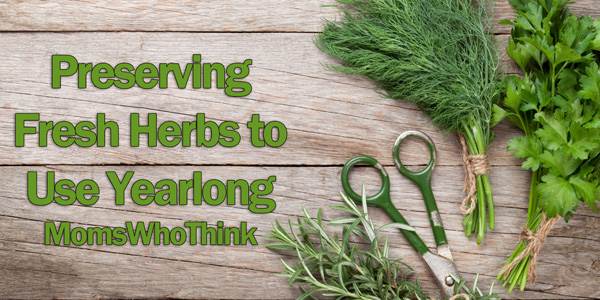Preserving Fresh Herbs
Preserve Your Fresh Herbs to Use Yearlong
Did you know for years and years, healers have used herbs for medicinal purposes. Modern science has confirmed that basil, cardamom, cilantro, cumin, ginger, nutmeg, oregano, rosemary, saffron, sage, tarragon, thyme, and turmeric are known to have antioxidant properties that can protect cell damage from many diseases, including cancer.
Enjoy the fresh flavors from your herb garden’s bounty all year long with these preserving tips. Dry or freeze, or do a combination depending on the herb, these are some helpful tips to get you started.
Drying Herbs
• Leaves should be dry and crispy. They should crumble if rubbed between your fingers.
• Rosemary shouldn’t be dried.
• To prevent mold, tie smaller bunches so that the air moves freely between the leaves.
• After herbs are fully dry, store in jars or other airtight containers for up to a year.
• Save stems of herbs, mince and use to add flavor to sauces, soups, and stews.
• Microwave drying works best on mint, oregano, and tarragon.
Three Drying Methods:
1. Air-drying – Tie small groups of 4-5 stems together and hang them upside down in a dust-free area that’s dark, warm, and well ventilated.
2. Paper bag drying – Cover herbs loosely with a paper bag (not plastic) and keep out of light for 2-4 weeks. The darkness preserves the color in the leaves.
3. Oven drying – Clean the stems and pat dry. Arrange them on a cookie sheet in a single layer. Set temperature to 180°F and bake, with the oven door open, for 4 hours. Tip: Use the microwave oven to speed up the process. After the stems are clean and completely dry, place the stems in single layer between two paper towels and microwave on low. Check every 30 seconds until the herbs are brittle and ready to be stored.
Freezing Herbs
• Freezing works best with delicate herbs that won’t taste as good dried, such as basil, dill, chives, chervils, and parsley.
• Use a salad spinner to help dry freshly washed leaves.
• For food-processor and hand chopping, make sure herbs are fully dry before processing.
Two Freezing Methods:
1. Freeze in plastic bags – Wash and thoroughly dry the stems, then place in a sealable plastic bag and place in the freezer. Repackage the leaves a week later to take up less space.
2. Freeze in ice cube trays – Wash and chop the herbs. Divide ½ teaspoon portions into each tray cup and cover with water or olive oil and freeze. Remove the cubes and store in airtight containers.
The image featured at the top of this post is ©iStock.com/karandaev
